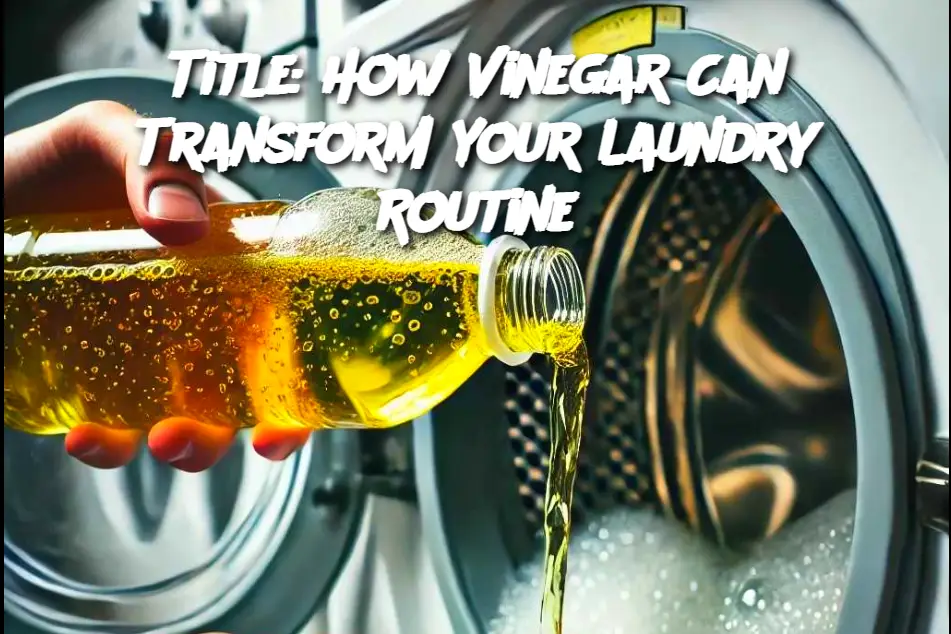-
Softening Towels:
-
Add 1/2 to 1 cup of white vinegar directly to the rinse cycle. The vinegar breaks down detergent residue that can make towels stiff and rough. You’ll notice that your towels come out fluffier and more absorbent.
-
-
Whitening Laundry:
-
For whites that have dulled over time, pour 1/2 cup of vinegar into the washing machine during the wash cycle. Vinegar’s mild acidity helps lift stains and restore a brighter appearance to your clothes.
-
-
Enhancing Fragrance:
-
If your clothes have a lingering musty odor or you just want them to smell fresher, vinegar can help neutralize odors. For added freshness, mix a few drops of your favorite essential oil with the vinegar before adding it to the rinse cycle.
-
-
Preserving Colors:
-
Use 1/4 cup of vinegar in the rinse cycle for colored garments. This helps set the dye and reduces fading, keeping your clothes looking newer for longer.
-
-
Cleaning the Washing Machine:
-
Don’t forget that vinegar can also help maintain your washing machine. Run an empty load with hot water and 2 cups of vinegar once a month to remove buildup, keep the drum clean, and prevent odors.
-
Serving and Storage Tips (Making the Most of Vinegar in Laundry):
-
Use Distilled White Vinegar: Other types of vinegar may leave stains or residues. Stick with distilled white vinegar for the best results.
-
Keep a Dedicated Laundry Bottle: Store a separate bottle of vinegar in your laundry room so it’s always on hand when you need it.
-
Add During the Rinse Cycle: Adding vinegar at the right time ensures that it doesn’t interfere with your detergent and works most effectively.
-
Check Labels: Before using vinegar on delicate fabrics or specialty garments, consult the care label to ensure it’s safe.
Variants (Additional Vinegar Tips for Laundry):
-
Homemade Fabric Softener Alternative: Mix 1 cup of vinegar with 1/4 cup of water and a few drops of essential oil. Add a small amount to the rinse cycle for an all-natural fabric softener.
-
Stain Pretreatment: Combine vinegar and water in a 1:1 ratio to create a simple stain remover. Apply directly to stains before washing.
-
Static Reduction: Using vinegar in the rinse cycle can help reduce static cling, eliminating the need for dryer sheets.
-
Boosting Detergent Performance: Adding a half-cup of vinegar to your load can enhance the cleaning power of your regular detergent, resulting in fresher, cleaner clothes.
FAQ:
Q: Will my laundry smell like vinegar?
A: No. The vinegar smell typically disappears during the rinse cycle and drying process, leaving clothes odor-free. If you’re concerned, adding a few drops of essential oil can provide a pleasant scent.
Q: Can I use vinegar on all fabrics?
A: Vinegar is generally safe for most fabrics, but always check the care label and avoid using it on delicate materials like silk or specialty finishes.
Q: Does vinegar replace detergent?
A: Vinegar is not a detergent substitute. It works best as a complementary product to soften fabrics, remove odors, and brighten clothes.
Q: How often should I use vinegar in my laundry?
A: You can use vinegar in every load, but even incorporating it occasionally—such as when washing towels, whites, or musty clothes—can make a noticeable difference.
Q: Is it safe to use vinegar in a high-efficiency (HE) washing machine?
A: Yes. Vinegar is safe for HE machines. Just add it to the designated fabric softener dispenser or directly into the drum during the rinse cycle
